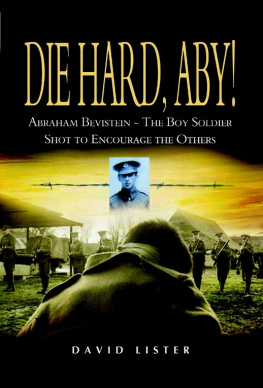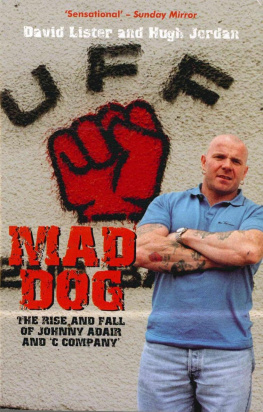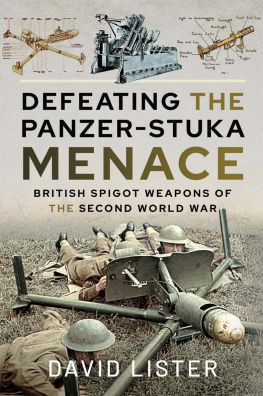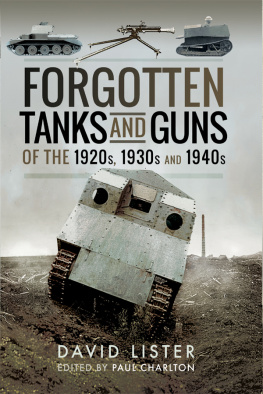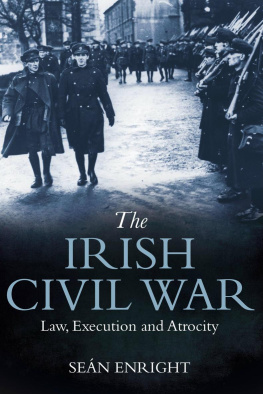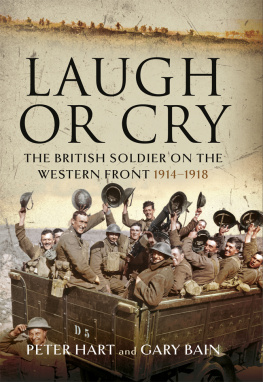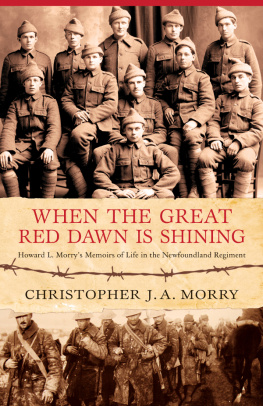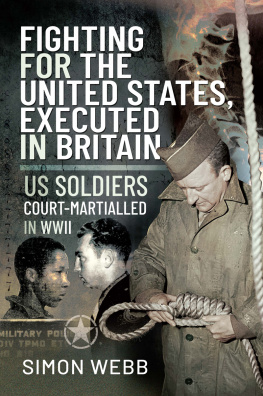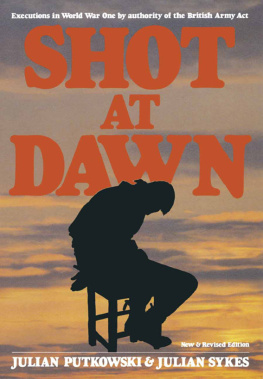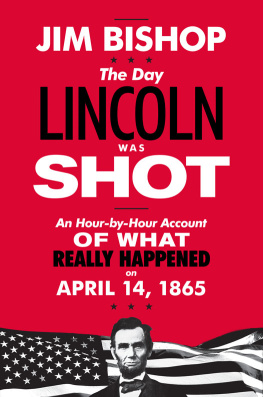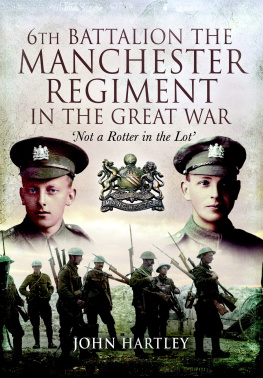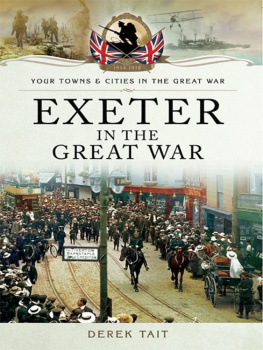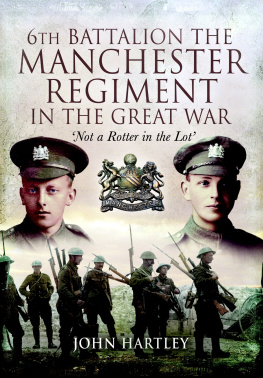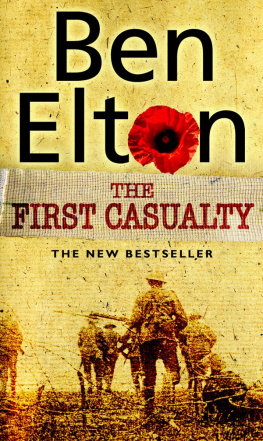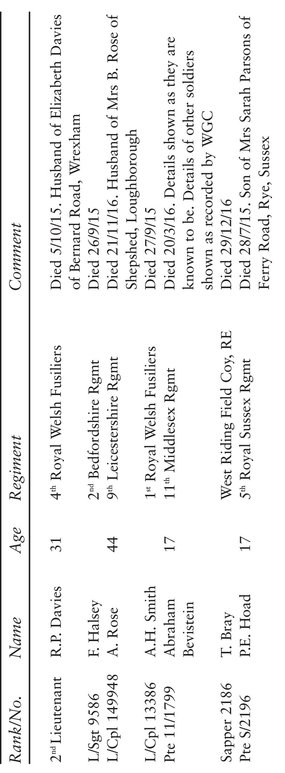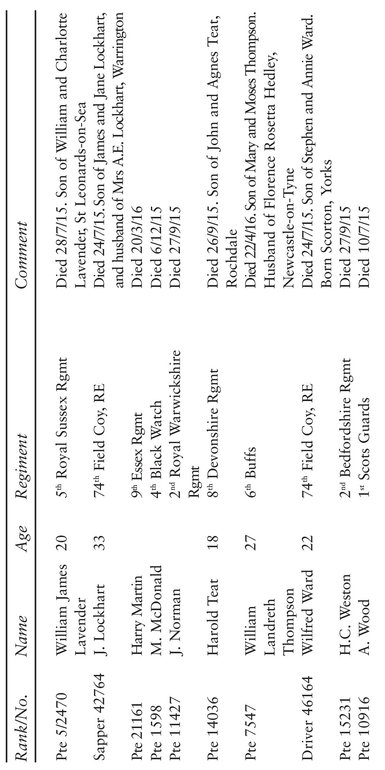Acknowledgements
Aby has led me to some amazing places since I started to research his life and times. It all came about when my son was assigned to complete a school project about Field Marshal Douglas Haig. Knowing a little about those who were shot at dawn, I thought he would get a paragraph or two from the subject. Then we discovered Aby. My sons project was soon completed, but Aby kept niggling me. Find out more about me! he seemed to say. But Im not going to make it easy! he would add with a mischievous grin.
My hope for the future is that Abys story will come to be known as widely as possible, which is some compensation for the stigma still attached to his name, that successive governments, to their great shame and dishonour, will probably never lift. Maybe there are dusty diaries somewhere or old photo albums where more details of Abys life might be hidden. Perhaps the missing letters will one day turn up. Stranger things have happened.
In the eighteen months or so it has taken me to research and write up an account of his life, I have been fortunate to find help at almost every turn, whether it be from patient archivists at the London Metropolitan Archives, Public Record Office staff or the National Army Museum, to individuals who have given their time and knowledge to help Abys story come to light. I have learnt many things during the journey, not least of which is to keep better tabs on my sources. I have quoted as many of them as I can in the Sources and Bibliography but there have been so many, especially on the Internet, that the list is woefully inadequate.
My first acknowledgement must be to the many unsung contributors to the global body of information that is the World Wide Web. Dipping into this staggeringly vast mass of information has saved me time immeasurable and has guided me to sources and archives of which I would never otherwise have heard.
These acknowledgements would be incomplete without the mention of certain individuals. The first that must be cited is George Coppard, whose work I have quoted often in Die Hard, Aby! He was in the same division as Aby, and often their respective battalions were working in close proximity. To anyone who wants to hear more first hand accounts of a soldier who served in the same locations as Aby, I commend his book, With a Machine Gun to Cambrai , which at the time of writing, is still in print and available from Cassell Military Paperbacks.
I would like to thank John Hipkin for all his hard work and dedication to the cause of the 306 men and boys executed for military offences. A pen and paper man, he co-ordinates the campaign for pardons without such modern necessities as a computer. I thank him for putting me in touch with many people who have been able to point me in the right direction or guide me away from dead-ends. I am also grateful to Anne Mary Jayes who spoke to me of her fathers pain at having to command a firing party to shoot a poor frightened boy. Thanks also to author Richard van Emden for guiding me to some Hansard references concerning Aby that I had previously overlooked.
Betty Jacobs is Abys only surviving niece and I would like to thank her for sharing her East End memories and for the excellent photograph of Aby with his mother, father and sister Kate on the occasion of his bar mitzvah. Betty has been very encouraging throughout this project, and I only hope the work meets expectation. Thanks also to Hew Strachen for answering my query concerning the matter of cocaine being given to men at the front. Thank you Sam Seager, for directing me towards the on-line facility for searching the registers of The Poor Jews Shelter, and to other resources within the PRO.
Thanks to my wife Marion, for reading endless reams of first draft sections, and doing more than her share of the domestic chores while I scribble away or visit dusty archives. Also to the patience of my sons, Michael and Nathan.
A little of Abys story was included in a Channel 4 dramatized documentary and I would like to thank Testimony Films especially executive producer Steve Humphries and producer/director Neil Rawles for the care they took to get the story as close to reality as dramatic interpretation would allow. And thank you to actor Josh Maguire who portrayed Aby. I was able to observe much of his work from behind the camera and on the lip of the trench, and I was moved by his acting and impressed by his care to get it right. The finished work, Britains Boy Soldiers, was first shown in June 2004 and received much critical acclaim, Abys story especially, catching public interest. Many thanks indeed to Lizi Cosslett of Testimony Films for her successful efforts to help me secure use of some of the photos included in Die Hard, Aby! , and for a thousand and one other contributions that have helped Abys story towards the light of day. Thanks also to photographer Simon Rawles for his kind permission to use the two excellent shots of Aby as portrayed by Josh Maguire.
I am very grateful to Brigadier Henry Wilson and the staff at Pen & Sword Books for seeing the potential in Abys story, and especially to Kirsten Barber for knocking the rough edges off my work and for unravelling my convoluted sentences.
My final and most heartfelt acknowledgement must go to Tommy. Private Tommy Atkins. RSM Tommy Atkins. Even Lieutenant Thomas Atkins. In all his ranks, in all his roles, in all his many guises.
Appendix I
Final Parade at Labourse
Such discipline on Parade
Would put to shame a Guards Brigade:
So long, so rigid, to remain like this
And still o order to dismiss
William Clarke
Those on Final Parade with Aby, in Labourse Communal Cemetery
Appendix II
Goodbye, the Old Battalion
A letter from Lieutenant General, Adjutant General to the Forces, to the Lord Mayor of London, 30 November 1918, tells what became of Abys battalion.
My Lord
I forward the following brief statement of the services rendered to the country during the present hostilities by the 11th (Service) Battalion, The Duke of Cambridges Own (Middlesex Regiment) feeling sure that it will be of great interest to you and to all those connected with the Regiment.
The recent re-organization of Infantry in France involved the disbandment of certain Battalions amongst which is the 11th (Service) Battalion, The Duke of Cambridges Own (Middlesex Regiment).
The Battalion was formed on the 26th August 1914, and after training in England the battalion left Aldershot for France on May 31st 1915, landed at Boulogne June 1st and proceeded to the Armentieres area for instruction in trench warfare being attached to its own 1st Battalion.
It was in this area till the end of September, carrying out some successful bombing raids. On September 30th it took over part of the German positions captured North East of Vermelles and assisted to consolidate and hold these against German counter attacks.
It remained in this neighbourhood for the last three months of 1915 and first half of 1916, repeating an attack near the Quarries on February 13th for which it was specially congratulated by the General Officer Commanding, First Army, and carrying out several minor operations, including a very successful raid on February 29th.

